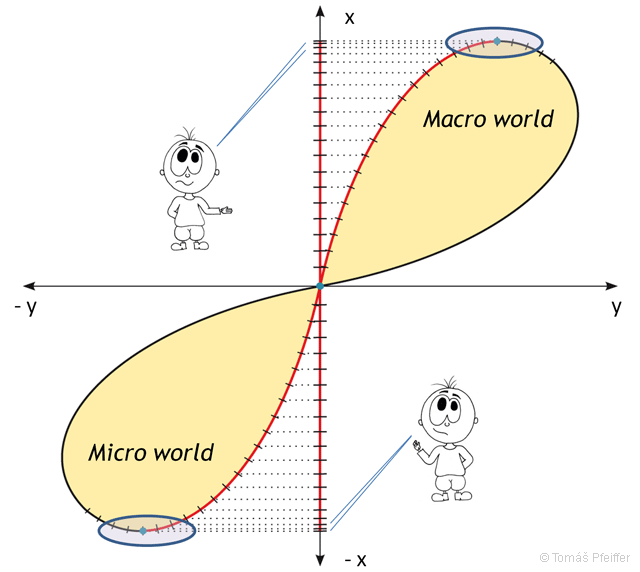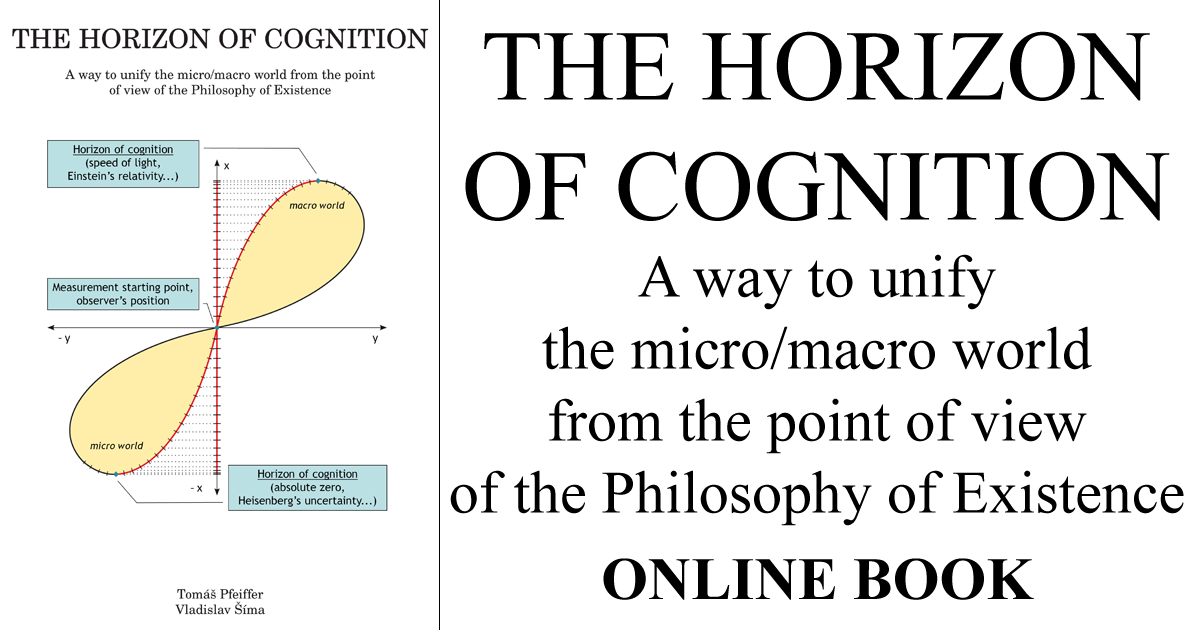Chapter 2
The Philosophy of Existence
2.3 Quantisation of spacetime
2.3.6 The horizon of cognition and spacetime quanta
Let’s take another look at the horizon of cognition. If we observe an object (interval) that is close to us in time, space or any other dimension, we perceive it as a clear, tangible and certain object (see Fig. 2.6).

Figure 2.6: Observing intervals close to the observer. Here we perceive everything clearly, without any distortions. Time and space seem to be a perfectly continuous, uniform continuum. Any error in its quantification is negligible.
But if the object/interval is distant from the observer in time, space, or any other dimension, the object becomes more and more uncertain to the observer; the measurement error keeps growing creating the phenomena of uncertainty. All interval increases blend together and, not being able to distinguish them from each other, we perceive them all at once. Upon reaching the horizon of cognition, a measured object/interval does not grow any larger; beyond the horizon of cognition, we are no longer able to observe the object and so we perceive it as disappearing completely. According to philosophy, this holds true not only for space and time dimensions but for literally anything that can be regarded as an interval (see Fig. 2.7).

Figure 2.7: Observing intervals distant/far from the observer. Here the spacetime uncertainty is manifested. When trying to quantify, the measurement error grows steeply and once we reach the horizon of cognition, it is infinite. We no longer perceive any increase in an actual interval as an increase on the x-axis. The intervals can only be recognised by changing the observer’s position.
Going into the micro world, we do not perceive particles close to the horizon of cognition as having a single specific time or a single specific projection (!). We can only perceive them as “spread across” time and space.
The oscillating nature of time and space implies that in our perception, we cannot consider spacetime in its manifestation near the horizon of cognition as a continuous quantity. To us distant observers, space and time seems to divide into interconnected intervals (spacetime quanta), each of which must also have its negative counterpart (or else it would not be possible according to the law of duality). These then line up one after the other and we are not able to distinguish between them. The particles thus become uncertain in time and space, which directly leads to Heisenberg’s uncertainty principle (1.1).
Since particles cannot exist in two states at once, we perceive them as fluctuating, i.e. oscillating between the two states. This explains the essence of the wave particle dualism.
Yet all the intervals are interconnected. Under common circumstances, no two intervals can be disconnected from each other, as spacetime is a oneness.
To understand the phenomena observed by quantum mechanics we have to abandon our current notion of the continuity of time and space.
At the horizon of cognition, not only space, but also time (!) is quantised, and a time quantum may appear and behave similarly to a quantum particle, i.e. jump back and forth like a quantum particle. Because time, like a particle is an interval just like everything else.
The quantisation of time thus also fundamentally affects the perception of causality.
Note: If we have connectedness and continuity on the one hand, then according to the law of duality, disconnection and jumps across time and space must also exist under certain conditions (step changes in regular intervals). This could be the subject of further philosophical-scientific research, and one day it may open up the possibility to time travel i.e. step changes in spacetime. Although it has not yet been studied by science, intervals perhaps evidently do sporadically disconnect and reconnect.
Time oscillations are incredibly fast (given by the speed of light) and they do not manifest when observing nearby objects; we perceive everything continuously. We can use a film stock as an analogy; a number of static pictures are projected one after another. If they are projected quickly enough, we perceive them as a continuous event. This is the case with all common events around us.
However, when we observe microparticles near the horizon of cognition, we are in fact observing an object whose “own” proper time runs unimaginably much faster than the time in our spacetime. In comparison to our time, the particle’s own proper time is accelerated by many orders of magnitude and it draws close to the frequency of time oscillations in our spacetime. At that moment, our observations show the particle crumbling into the many possibilities in which may exist in time and space – like individual slides on a film stock – and we are not able to distinguish between them.
The result is a time and spatial dispersion of its possible and impossible (the dual counterpart) occurrences, which in our observation manifests itself as a wave, with all consequences. We are already not able to differentiate between the time oscillations. From our perspective of time and space, the observed object disintegrates (crumbles, splits) into a set of possible (spacetime) states, which are perceived simultaneously.
It is important to remember, that the quantisation of time and space in fact exists and does not exist simultaneously. This phenomenon must be regarded as a direct consequence of the horizon of cognition; this is how the horizon of cognition manifests itself in our observation (with all consequences for geometry, forces, etc.) – in all directions (in this case into the micro and macro world).
The same rules apply to extremely long segments of spacetime and extremely short ones. Further increases in large segments of spacetime are quantised just the same as in the micro world. We are not able to observe the real universe the same way we are not able to observe a real particle. What we observe is actually an imaginary bubble, in which we are only able to see up to the limit of the horizon of cognition, whichever direction we look in.
Read more >>

